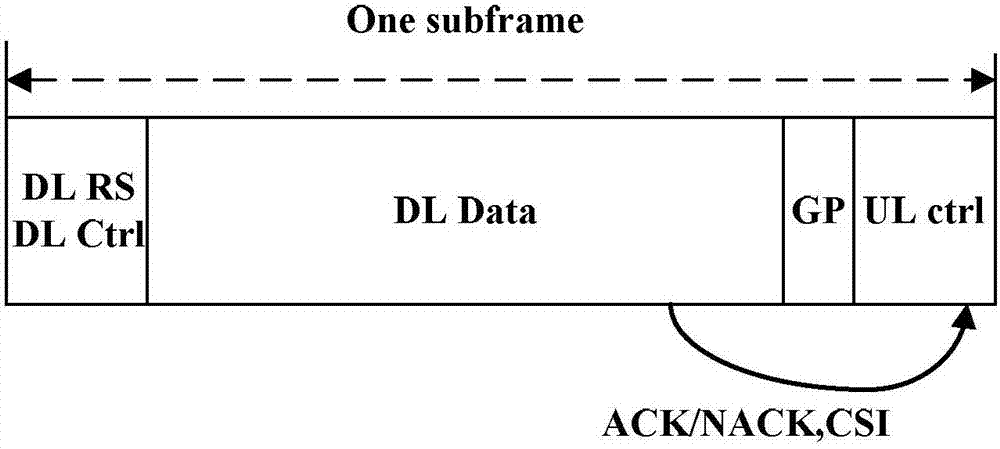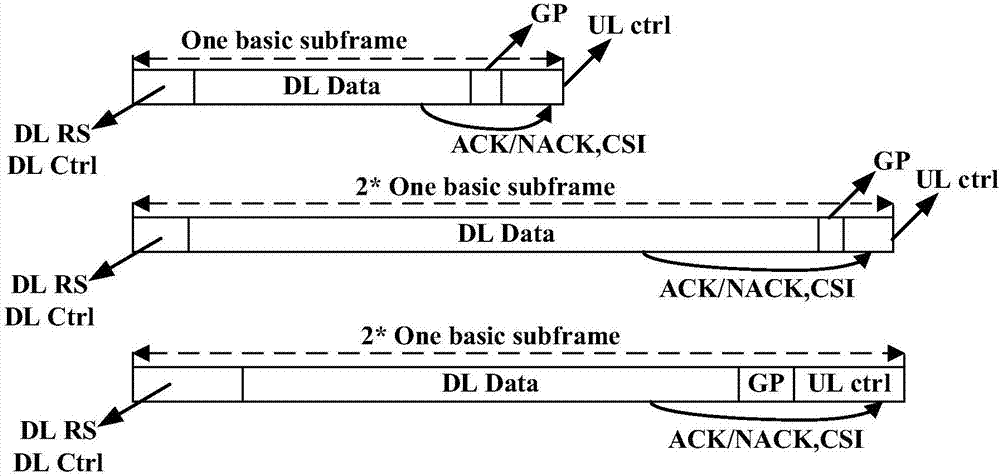Method and device for signal transmission
A signal transmission and signal technology, applied in the field of communication, can solve problems such as difficult to support low-latency services
- Summary
- Abstract
- Description
- Claims
- Application Information
AI Technical Summary
Problems solved by technology
Method used
Image
Examples
Embodiment 1
[0358] see Figure 4 , the present invention proposes a signal transmission method, the method comprising:
[0359] In this example, the combination order of subframes is subframe 1, subframe 2, and subframe 3, where subframe 1 is a short TTI, subframe 2 and subframe 3 are long TTIs; where a short TTI includes a BRU, and a short TTI The feedback of the TTI follows the timing of n+2; the long TTI includes four BRUs, and the feedback follows the timing of n+1, where n=1 and 2 are both length units relative to the TTI type.
[0360] Each TTI includes a DC (downlink control) area, a Data (data) area and a UC (uplink control) area. Wherein, Data may be an uplink data area or a downlink data area.
[0361] Step 410, the terminal receives DL Control and DL data that need to be fed back in the Data area of subframe 1;
[0362] According to the preset feedback mechanism, the terminal needs to send feedback signals corresponding to DL Control and DL data that need to be fed back in...
Embodiment 2
[0397] In this embodiment, another multiplexing solution in which long and short subframe TTIs belong to the same user is introduced.
[0398] There may also be a possible solution to the mixture of long and short subframes, that is, the long TTI transmits the control information that needs to be fed back in the short TTI, and needs to be multiplexed with other feedback information of the short TTI. Such as Figure 7 As shown, the long TTI is followed by 4 short TTIs. According to the feedback timing of the long TTI n+1, the feedback is falling into the uplink time slot of the fourth short TTI, which needs to be multiplexed with the uplink control information originally undertaken by the short TTI. .
Embodiment 3
[0400] In this embodiment, a solution that the long and short subframe TTIs do not belong to the same user is introduced.
[0401] In the case that the long and short subframes belong to different users, for example, the short subframe is a low-latency Internet of Things (uMTC) user, and the long subframe is a mobile user (MBB) with general wide-area coverage. The usage is consistent with the method that the long and short subframe TTIs belong to the same user. But because the two users are separated, the terminal capabilities of the two users, such as whether they have self-feedback, cannot be directly transmitted, and the acquisition of their prior information is more complicated. When the feedback signaling of the uMTC user needs to be carried in the data part of the MBB user, and the terminal capability of the uMTC user cannot be directly transmitted to the MBB user, it needs to be conveyed by the base station. The base station notifies the user of the allocation mode of ...
PUM
 Login to View More
Login to View More Abstract
Description
Claims
Application Information
 Login to View More
Login to View More - R&D
- Intellectual Property
- Life Sciences
- Materials
- Tech Scout
- Unparalleled Data Quality
- Higher Quality Content
- 60% Fewer Hallucinations
Browse by: Latest US Patents, China's latest patents, Technical Efficacy Thesaurus, Application Domain, Technology Topic, Popular Technical Reports.
© 2025 PatSnap. All rights reserved.Legal|Privacy policy|Modern Slavery Act Transparency Statement|Sitemap|About US| Contact US: help@patsnap.com



